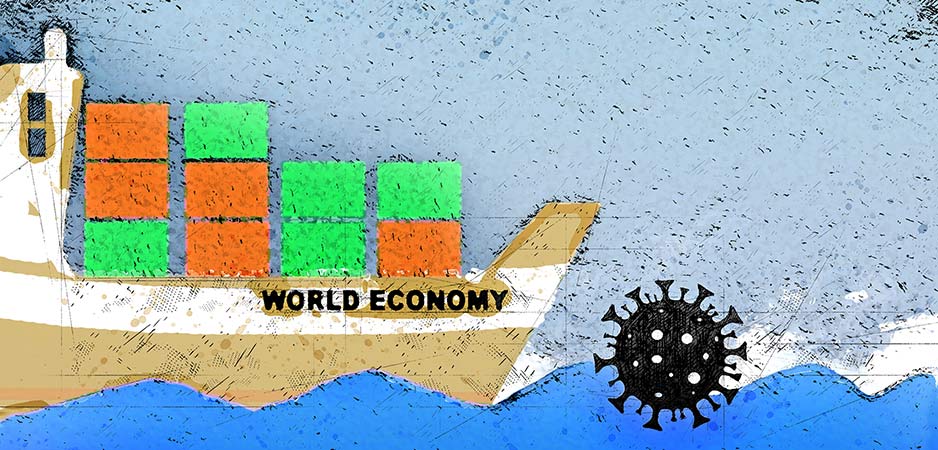
Now that the disease caused by the new coronavirus, officially designated as COVID-19, has become a global pandemic, spreading throughout Europe, North America, and beyond, no one can venture economic forecasts with certainty. Nonetheless, a worrisome picture emerges, enabling some preliminary analysis.
It is now clear that the impact of COVID-19 on the global economy will be unprecedented. Perhaps the closest historical parallel is the 1918 flu pandemic, but that was a different era. The global economy was just emerging from the shock of World War I with much lower levels of integration. And the SARS crisis in 2003, or other recent epidemics, such as Ebola and MERS, pale in comparison to the global scale, rapid spread, and deep economic impact of this pandemic.
COVID-19 is simultaneously creating three types of economic shock that are rippling across the globe. The first became prominent as China shutdown most industrial activity due to the virus outbreak in February 2020. This generated various shortages of materials and industrial inputs, creating a “supply shock” that impacted global value chains ranging from electronics to cars and biopharmaceuticals.
Many industries in the West, Japan, South Korea, and beyond warned of serious problems in their supply chains if China’s industrial shutdown continued beyond March. Fortunately, China has been able to gradually return to work. Big industries were the first to reopen, now being followed by many smaller firms.
Most global manufacturers and retailers have been able to work around shortages by having sufficient inventory, sourcing parts from countries other than China, or air-shipping parts from China after the resumption of work there. The big exception is medical equipment, such as face masks, testing kits to detect the virus, and personal protective equipment for medical workers. All of these are in extremely short supply globally.
The second shock rippling across the globe is a massive “demand shock”. Even if Chinese industry is reopening and reaching production capacities close to before the outbreak of COVID-19, there are no customers. Other economies are facing shut-downs similar to what occurred in China. Key parts of Europe and North America are the new hot spots of the pandemic.
As various economies institute lockdowns of their citizens, demand for services ranging from entertainment to retail and tourism is falling off a cliff. Secondary ripples have now reached manufacturing, such as all industry in Northern Italy and automobiles in the United States. A sustained disruption of activity in North America and Europe will reverberate back to China, causing disruptions to manufacturing activity there.
As one element of the global economy after another shuts down or is deeply impaired by the pandemic, the specter of mass bankruptcies rises. A classic depression feedback loop as outlined by John Maynard Keynes could become reality once again. Companies would lay off workers. Workers would not be able to consume much, lowering demand for the remaining industries, which would, in turn, lay off more workers. It ends with companies having to shut down, creating yet more of a downward motion.
Therefore, the most dangerous economic shock produced by COVID-19 is financial. Already world equities have been extremely volatile and on a downward trend. More ominously, credit markets have been freezing up, forcing the US Federal Reserve to decisively intervene with massive infusions of liquidity and other measures.
The Fed’s actions have truly kept the basic functioning of the financial system intact by providing dollar liquidity to both domestic and international markets. Similarly, various governments in Europe, Asia, and North America have stepped up and announced enormous fiscal spending plans. All of these aim to halt the downward spiral, as if putting a patient in a coma on life support.
The measures are varied, but many aim to give workers much needed props, either via forestalling lay-offs, replacing wages with government payments, or expanding unemployment insurance. Moreover, the United States and Hong Kong have both announced direct payments to residents to support consumption.
These extreme Keynesian efforts at supporting aggregate demand will surely help in the short term, but much will depend on implementation and, ultimately, the duration of the pandemic. If the pandemic lasts, even in a less-intense manner, aggregate demand could continue to suffer.
The greatest trepidation is therefore that a lasting downturn will trigger mass bankruptcies, especially for those businesses with too much debt, of which there are many. A wave of defaults could first hit many small- and medium-sized enterprises, but rapidly spread to larger corporations.
Once this chain reaction is set in motion, it will be difficult to arrest. Cascading bankruptcies, loan defaults, and business failures would impair the credit of financial institutions, setting off an insolvency crisis, during which no one would be willing to lend out money. The resulting credit freeze, the beginnings of which we have seen, could dwarf the effects of the 2008 financial crisis.
Policymakers are aware of these dangers. Various initiatives both on the monetary and fiscal side have been taken that have so far been quite effective in forestalling a financial meltdown. The two trillion-plus US dollars CARES act just signed by President Trump aims to ease credit access for small enterprises and provide many with grants to tidy them over hard times, especially in keeping workers employed.
We have learnt from past crises, both the 2008 Global Financial Crisis and the Great Depression. But in the end, this pandemic is creating a demand shock of unforeseen proportions. If this shock lasts and triggers a financial shock due to mass bankruptcies, all bets are off.
Let us hope it does not come to this and that the measures taken so far and in the near future are sufficient. But policymakers need to be laser-focused on how these shocks can feed upon themselves and trigger downward spirals resulting in depression-like economic outcomes. Ideally, the leading economies would cooperate much more closely and launch coordinated fiscal spending and other measures. The world’s central banks have already done so. Now national governments need to go further.
